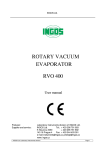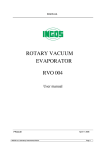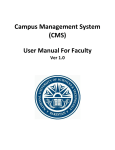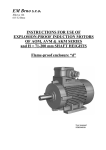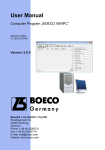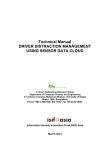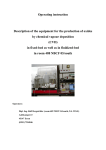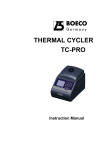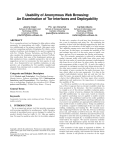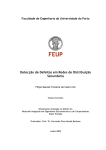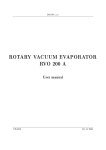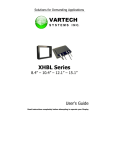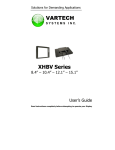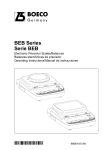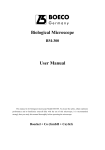Download Manual - Boeco
Transcript
ROTARY VACUUM EVAPORATOR RVO 400 SD User manual Boeckel + Co (GmbH + Co) Kg. Roedingsmarkt 33, 20459 Hamburg, Germany Phone + 49 40 325627 0 Fax: + 49 40 425627 41 E-mail: info@boeco.com Web: http://www.boeco.com BOECKEL + CO (GMBH + CO) KG Page 1 1. INTRODUCTION Innovated Rotary vacuum evaporator BOECO RVO 400 SD is new advanced model with system designed for the control and communication by PC with the possibility to data entry of pre-set values and date processing while evaporating . Is noted for affability value in-use and compact construction. Innovated design offer users comfort and safety using the remote control and safety bath cover. Optional is possible to equip RVO 400 SD with the regulation in accordance by steam temperature . 1.1 Apparatus use and specifications Rotary vacuum evaporator RVO 400 SD is designed for low-pressure evaporation at the pre-set value of the heating bath temperature and at the pre – defined constant mixing process of the solution to be vaporised. The vapours exhausted condense in a vertical or diagonal cooler and are collected into a flask. The apparatus is fitted with a digital vacuum control and measuring system. Vacuum ratio is driven by diaphragm vacuum pump control. User comfort assure heating bath equipped with motorized lift and manually tilted rotary casing head. Rotation of the evaporating flask, height of the heating bath, steam temperature , the vacuum ratio and length of evaporation can be digitally set and controlled using the Keyboard or PC. All controlled values can be stored in memories. Standard glass assembly can be adapt or enlarged on request. 1.2 Technical characteristics Evaporating flasks ................................................... 20 – 4000 ml Rotation speed ........................................................ 0, 10 up to 280 rpm Bath temperature ....................................................max. 100°C for water filling max. 180°C for oil filling Regulation accuracy ................................................ ±1°C up to 100°C ±3°C up to 180°C Pressure measurement…………………………… absolute Pressure difference ...................................................adjustable 1-500 mbar Power supply ........................................................... 230V, ±10%, 50Hz Power input ............................................................ max.2000 W (excluding vacuum pump ) Weight without glass .............................................20 kg Dimensions (w x h x d) ......................................... 650 x 900 x 360 mm (including glass) 1.3 Symbol Explanation - hot surface BOECKEL + CO (GMBH + CO) KG Page 2 2. TECHNICAL DESCRIPTION Individual parts of the evaporator and their location can be seen on fig. 1. 6 2 9 4 8 5 10 12 11 3 7 13 1 1. 2. 3. 4. 5. 6. 7. 8. Stand 9. Rotary casing head 10. Heating bath 11. Suck pipe 12. Ball adapter 13. Condenser Receiving flask 1000 , ball KS 35/20 Round bottom flask 1000 and 2000 ml, NS 29/32 Filling pipe with valve Fixed clip Head tilt stick Lift top position stopper screw Keyboard (see Fig.6) Fig.1 Location of individual parts of RVO For complete list of basic accessories see paragraph 7.2.1. BOECKEL + CO (GMBH + CO) KG Page 3 3. STARTING OF OPERATION 3.1 Unpacking of the apparatus Unpack the apparatus from the transport package, check the evaporator’s surface and check all items according to the delivery note. If the apparatus is damaged or if an item is missing, contact your supplier or the manufacturer. Caution: apply silicone Vaseline to the all joints of the glass assembly. 3.2 Apparatus assembly 1. Keyboard can be hanged on the left fourpod leg of the stand apparatus or can be laid beside it. Plug connection cable in to the keyboard and to the socket at the back of apparatus marked KEYBOARD (fig. 2). 2. Place the heating bath on the lift table fig. 1, insert the bath cable into the socket under the mains switch (fig. 2 pos.10) and plug the connector of the bath temperature sensor into the socket (fig. 2 pos.3) marked TAC THERMOMETER. 3. Pour approximately 1 l of liquid into the heating bath. Fig. 2. Connectors BOECKEL + CO (GMBH + CO) KG Page 4 4. Rotation blocking knob, which is placed on the rotary casing head, set to the ”Lock” position (marking by red point) (for easier locking try to turn the casing a little). Insert suck pipe in to the rotary casing until the sitting touches the plastic collar. Than tighten the nut on the rotating casing. Finally ”Unlock” the blocking knob (marking by green point). 5. The opposite side of the head with the rotary casing contains a fixed housing with a nut. Unscrew the nut (fig. 3 pos.2), put it on the fitted part of the ball adapter (fig. 3 pos.1), insert the bead-type securing ring (fig. 3 pos.3) in such a way that it can latch behind the fitted part of the ball adapter. Check that the gufero sealing, treated with silicone Vaseline, has been inserted inside the fitted part (fig. 3 pos.4), its open side should face out of the fitting. Check that the flat sealing (fig. 3 pos.5) has been inserted in the casing and put carefully the ball adapter with gufero and nut on the suck pipe (fig. 3 pos.6), push the ball adapter until it stops and tighten the nut properly (fig. 3 pos.2). The spherical joint of the ball adapter faces down. 6. Do not forget to apply silicone Vaseline to all glass parts joints. 7. Install the condenser into the joint in the upper part of the ball adapter. The upper outlet of the condenser serves for the connection of the vacuum source. Connect the outlet of the condenser to the socket for the measurement of vacuum, marked VACUUM, and to the vacuum source with the help of a ”T” union. Other outlets serve for connection of cooling water. 8. Attach the receiving flask with ball joint to the ball adapter with the help of a fixed clip, tighten properly. 9. Put the round bottom flask on the pipe and secure it with a wire combi-clip. 10. Insert the filing pipe with a valve (valve closed) into the ball adapter. BOECKEL + CO (GMBH + CO) KG Page 5 1. 2. 3. 4. Ball adapter Nut Bead-type securing ring PTFE sealing 5. -----6. Housing 7. Suck pipe Fig. 3c. Ball adapter sealing (chemical resistant) BOECKEL + CO (GMBH + CO) KG Page 6 1. 2. 3. 4. Ball adapter Nut Bead-type securing ring Gufero sealing 35/22/10 5. Flat sealing 6. Housing 7. Suck pipe Fig. 3a. Sectional assembly view (low chemical resistant) BOECKEL + CO (GMBH + CO) KG Page 7 1. 2. Cooling water outlet Cooling water inlet 3. “T” tube connection 4. Vacuum connection Fig. 4. Tube connection scheme 11. Connect the main cord. (fig. 2) 12. Lift the heating bath using the lift to its working position. At the bath top position adjust the lift stopper and fill in the liquid in the heating bath in such a way that the round-bottom flask can be sufficiently immersed in the liquid. The maximum liquid level is approximately 20 mm below the edge of the heating bath. Flask can be immerse and emerge by tilt the rotary casing head. For tilt use stick on the left side of the apparatus. When tilt the head move stick carefully, pay attention to glass equipment. 13. When removing the round bottom flask, release the vacuum first (e.g. use the filling pipe valve). For easier manipulation use the rotation blocking knob to lock the rotation. Carefully unscrew the wire combi-clip, until the flask is released. During the flask removing, work with caution. 14. When the vacuum control is desired, connect the mains cable of vacuum pump into the socket on the back side of the apparatus. In this case connection between condenser vacuum outlet and vacuum measurement socket has to be established! BOECKEL + CO (GMBH + CO) KG Page 8 1. 2. 3. Cooling water outlet Cooling water inlet Vacuum sensor connection 4. 5. 6. Controlled vacuum pump plug socket ”T” union Vacuum pump Fig. 5. Connection plan for vacuum control Caution : It is not possible to use the glass part if it features visible scratches or any other defects ! W hen controlling the vacuum, only the diaphragm vacuum pump with maximum input 650 W, can be plugged in the evaporator! BOECKEL + CO (GMBH + CO) KG Page 9 3.3 Apparatus control The device is started up by switching the mains switch on. Upon startup, the display is lighted temperature Tac and pressure Pac is displayed. By repeated pressing the DISPLAY button the initial reading changes to Time. Buttons and control the lift movement and setting the values of the display. The upward movement of the solution is limited by an adjustable limit switch placed on the right side of the device stand (see fig. 1 pos.12). It is operated by means of a black knob. The downward movement of the solution is limited by a fixed limit switch. CAUTION! During upward movements of the warming solution, make sure that the solution does not overflow or that the glass parts do not get damaged. Fig. 6. Keyboard 3.3.1 RPM setup Pressing the ROTATION button once displays RPM setting on the display (by arrows) and pressing it twice starts the rotation. Pressing it once more the rotation stops. Pressing then the DISPLAY or ESC buttons returns the device into the initial display mode. Another pressing the ROTATION button displays again the RPM setup and one more pressing it stops the rotation. Correct operation is indicated by top right corner of the button lighting. Always make sure that the button of rotation blocking is in the position UNLOCKED. (If you start rotation with the blocking button in the LOCKED position, the case with the tube does not start rotating, just starts rotation lighting will flash. The apparatus enables you to set both directions of the rotation. The opposite direction of the rotation is indicated with the - minus sign. BOECKEL + CO (GMBH + CO) KG Page 10 3.3.2 Temperature setting In case the regulation is set according to the solution temperature Tac in the MENU position Heat, pressing the HEATING button once displays the solution temperature setting (by the arrows) pressing it once more, the solution heating is started. Pressing the button still once more switches the heating off. Pressing then the DISPLAY or ESC buttons returns the device into the initial display mode. Press HEATING once more and temperature setting displays again and another pressing the button switches the heating off. Correct function is indicated by top right corner of the button lighting in case of a failure the light starts flashing. If the vapor sensor is installed and in the MENU mode in Heat the regulation is set according to Tvap and the display is in the temperature setting mode, then the Tvap vapor temperature setting (optional) changes and the cooler temperature Tsol (optional) is only indicated. If any of the sensors is not installed for the corresponding temperature NO is displayed. Note: the solution temperature Tac must be set accordingly higher than the required vapor temperature Tvap. 3.3.3 Vacuum setting Pressing the VACUUM button once displays the vacuum value setting (arrows), pressing it twice starts vacuum control (if the vacuum pump is installed, see fig. 5). Pressing it once more switches the vacuum control off. Pressing then the DISPLAY or ESC buttons returns the device into the initial display mode. Pressing the VACUUM button again, the display will show vacuum value setting again and another pressing the button shall switch the vacuum control off. Correct operation is indicated by top right corner of the button lighting. 3.3.4 ENTER button function In all modes apart from MENU, pressing the corresponding button switches ROTATION, HEATING, VACUUM on/off. After recalling memory LOAD 1-4, functions of ROTATION, HEATING, VACUUM and TIME switch on/off. ENTER in the MENU mode is the selection confirmation. 3.3.5 DISPLAY button function Pressing the button cyclically changes the display mode and the arrows are active as lift movement controls. 1. Tac + Pac 2. Tvap + Tsol 3. Timer - if installed Pressing the DISPLAY button also overrides other display readings (Rotation, Vacuum, Heating). BOECKEL + CO (GMBH + CO) KG Page 11 3.3.6 MENU/ESC button function MENU Timer Heat Tac / Tvap Load memo Load #1 Load #2 Load #3 Load #4 Save memo Save #1 Save #2 Save #3 Save #4 Delta P Atmosf P Setting Pressure units Torr / mBar Temperature units °C / K Beep on/off Default yes/no Menu items: Timer - setting time countdown. If the time 00:00 is set, the operation time is not limited. When the time set is reached, the heating switches off, the solution moves down, rotation stops and also the vacuum pump is switched off. In case of failure, or stopping of the rotation or heating, the device switches off. Heat regulation - setting the heating regulation mode according Tac-solution temperature or Tvapvapor temperature. Load Memo - reading 4 device setups (the memory content is copied into the actual setup). Save Memo - storing 4 device setups (writing the actual setup into the memory). These parameters are stored : Pac,Tac,Tvap, Tac/Tvap regulation type, RPM, timer. Delta P - setting the pressure hysteretic for regulation within 1 to 500 mBar (setting the difference between switching the vacuum pump of and off) Atmosf P - if the absolute sensor is installed (optional) it shows the absolute pressure, it may not be edited. - if absolute sensor is not installed, the ambient pressure may be set manually according to a calibrated barometer. If 0 is set, the display shows the absolute value of the relative pressure. Setting - Setting parameters for the display module (units, lighting, contrast, beep, and return to factory setup). The values are stored directly in the display module and are valid for the specific module. ENTER selection confirmation ESC return After the device is switched on or when switching memory, rotation and heating the warming solution is switched off for safety reasons. We recommend controlling the RPM value set before you start the rotation. BOECKEL + CO (GMBH + CO) KG Page 12 3.3.7 Remote control (optional) Fig. 7. Remote control The LIFT button activates the arrows for lift movement (after a longer standby time it is necessary to activate them again) The ROTATION button displays RPM setting (by arrows) upon the 1st pressing, upon the 2nd it starts rotation. If pressed once more, the rotation stops. Correct operation is indicated by top right corner of the ROTATION button lighting – located on the keyboard with the display. The HEATING button displays a keyboard for temperatures Tac and Tvap setting on the monitor (by arrows) according to the regulation time set in MENU upon the 1st pressing. The 2nd pressing switches on the heating. If pressed once more, the heating is switched off. Correct operation is indicated by top right corner of the HEATING button lighting – located on the keyboard with the display. The VACUUM button displays vacuum value setting (by arrows) upon the 1 st pressing, upon the 2nd it starts vacuum control (if the vacuum pump is installed, see fig 5.) If pressed once more, the vacuum control is switched off. Correct operation is indicated by top right corner of the VACUUM button lighting – located on the keyboard with the display. The Display, after some 10 idle seconds switches to the initial readings. BOECKEL + CO (GMBH + CO) KG Page 13 3.3.8 Operating by PC (accessories by request) Install the program from CD to PC first. Interconnect PC and RVO 400 SD by the delivered link cabel (seriál port). Start program and now you can kontrol the instrument using PC. The changed parameters by PC will be rewritten also by display of keyboard and reversaly. PC requirements: Windows,office,seriál port or USB converter-seriál port. 3.3.9 Vacuum evaporating report by PC (accessories by request) Select under PC program mode of evaporating run, select name and enter. After push-button operation START the program is runing.For the each one data jogging you can create new databáze or select primary and the data are storaged as continuation storaged data before. The rekord consist of instrument setting and recording at selected scaning intervals. Create database Flask rotation Lift operating Time-like interval of scaning Getting of storrings memories1-4 Bath temperature* Error reporting and deletion Heating temperat.* Vapour tempera.* Temperatureof coolers vapour * START STOP Vacuum* Vacuum setting▀ Communication port selection Bath and vzpour temperature setting ▀ Err = Communication error OK = free and clear Setting of run time Program termination Pressure diference setting between ON and OFF of vacuum pump Static pressure setting in case without absolute sensor Static pressure * No = Senzore arn´t detected other way are displayed current values ▀ After setting required values enter - Write Fig. 8. Monitor PC BOECKEL + CO (GMBH + CO) KG Page 14 4. MAINTENANCE 4.1 Apparatus maintenance Do not leave the evaporator surface contaminated from corrosive substances. It could damage the evaporator coating. Clean the contamined surface with a clean soft cloth. The cloth may be moistened but not wet. It is also possible to use ordinary washing means for cleaning purposes. It is forbidden to clean the heating bath with the means which could spoil its smooth surface. In case of sediments of turning,impurities, particulates of water rusts ,use the cleaning compounds for cleaning of furning or mellow solution of HCL. In process of cleaning use the protective means recommended by producer of applied cleaning compounds. Caution: Disconnect the apparatus from the network while cleaning it with a wet cloth! 4.2 Sealing replacement Disassemble the condenser, remove the releasing pipe with the valve, remove the ball-andsocket ground joint flask, release the nut of the ball adapter and carefully remove the actual adapter. Release the gufero sealing, clean the ball adapter, slightly apply silicone Vaseline onto the new sealing and mount it into the ball adapter. The sealing cavity faces out of the ball adapter. If necessary, replace also the flat sealing between the ball adapter and the head fitted with a rotary casing. Perform the assembly according to the point 3.2. Apply a light layer of silicone Vaseline to the gufero sealing approximately after 80 operation hours (more often if necessary). 5. DEFECTS AND TROUBLESHOOTING 5.1 Leakage The main cause of leakage is usually an incorrect sealing assembly. At first you should check that all joints have been installed correctly. If it is the case, disassemble the glass and verify the condition of the ball adapter sealing and flat sealing, if necessary replace them. Carefully assemble according to the instructions, switch the rotation ON and start the vacuum pressure up. BOECKEL + CO (GMBH + CO) KG Page 15 5.2 Other failures The apparatus does not respond when you switch it ON. Check fuses, possibly replace with new ones featuring the same parameters (fig. 2, T 0.5A and T 10A). The window of the rotation key is flashing, rotating parts are not moving. Ensure that Rotation blocking knob is set to ”Unlock” and than press rotation key again. The window of the rotation key is flashing. Check that there is not anything which could impede the flask from its rotation (manually), switch the mains switch OFF and ON and press the rotation key again. The window of the temperature key is flashing. This indicates that the temperature sensor have been connected incorrectly. Check the sensor connection, quantity of liquid in the heating bath and switch the main switch OFF and ON and press the temperature key again. Controlled vacuum pump is not running, even the pump mains cable is correctly plug in the rear of evaporator as well as vacuum connecting hose. Check the vacuum pump fuse, possibly replace it with new one featuring the same parameters (fig. 2, T3,15A). 6. SAFETY AND OPERATION CONDITIONS 6.1 Operation safety Ensuring of rotation of the sample to be vaporized: Current protection of the driving motor. If the resistance against rotation has increased above the prespecified limit, the driving motor voltage will be disconnected. (This situation will be signaled by the flashing of the rotation LED) Protection of the heating bath lift: Friction coupling between the driving motor and lifting equipment. In the case of an increase in resistance during the lifting of the bath above the specified limit the friction coupling could slip. Protection of bath heating: Electronically by means of a thermal protection Against overheating. There will not be any heating if the incorporated sensor of the heating bath has been connected or if the difference of temperatures between sensors rises above the limit pre-specified by the manufacturer. (This situation will be signaled by the flashing of the LED for heating) BOECKEL + CO (GMBH + CO) KG Page 16 6.2 Operation conditions The apparatus is designed for the work under ordinary laboratory conditions at temperatures of 10 to 30°C and air humidity up to 80% . The power supply is 230 V, 10 A, 50 Hz. The inlet cord should be connected into a socket circuit featuring protection from 10 A or 16 A (diaphragm vacuum pump connected). The inlet cord cannot be in contact with the heating bath. The socket designed for the connection of the heating bath is designed exclusively for this bath. Oil used in the bath must be designed for a temperature of at least 180°C. The bath volume shall not exceed 2 l. It is forbidden to handle any bath which has been heated to a temperature exceeding 40°C in any other way than by using the apparatus lift. If you want to fill the liquid into the heating bath, always switch the vaporized sample rotation OFF. For temperatures up to 100°C use water as the filling of the heating bath (with regard to its higher thermal capacity). Caution! If you are replacing the round-bottom flask after the vaporized solution has become thicker, pay particular attention and if it is not possible to remove the flask easily from the cone, carry out any other handling only after the cooling of the bath. Caution! If you use oil as the filling of the heating bath, the heating bath must be properly dried before its being filled. Caution! If you are working with oil heated above 100°C, you must ensure that no water can enter into the oil. If you are replacing the round-bottom flask, pay particular attention that no water drops shall enter into the oil. While working, use personal protection equipment (goggles, gloves, coat and shoes). BOECKEL + CO (GMBH + CO) KG Page 17 7. ACCESSORIES AND SPARE PARTS 7.1 Basic accessories (comes with evaporator) Inlet cord Glass assembly Round bottom flask (1000 and 2000 ) NZ29/32 Receiving flask (1000 o ml) KS 35/20 Suck pipe Ball adapter Vertical condenser Filling pipe with a valve 3 pieces of GL14 connection fitting Sealing: gufero sealing 35/22/10 (Fig. 3a, pos. 4), flat sealing (Fig. 3, pos. 5), or gufero sealing 35/22/7 (Fig. 3b, pos. 4) with scraper ring Fixed clip Keyboard Adaptor Keyboard Cables 0.4 and 2m Tubing coupler PA vacuum tubing (100, 110 a 150cm) Main inlet cord 7.2 Other accessories 7.2.1 Glass accessories (Fig. 7) 4SKL0021 4SKL0025 4SKL0022 4SKL0023 4SKL0004 4SKL0003 4SKL0012 4SKL0017 4SKL0024 4SKL0006 4SKL0034 4SKL0005 4SKL0033 4SKL0020 4SKL0001 4SKL0002 4SKL0008 RO4810 RO3212 Evaporating flask 50 ml, joint NZ29/32 Evaporating flask 100 ml, joint NZ29/32 Evaporating flask 250 ml, joint NZ29/32 Evaporating flask 500 ml, joint NZ29/32 Evaporating flask 1000 ml, joint NZ29/32 Evaporating flask 2000 ml, joint NZ29/32 Evaporating flask 4000 ml, joint NZ29/32 (only RVO400) Receiving flask 250 ml, joint KS35/20 Receiving flask 500 ml, joint KS35/20 Receiving flask 1000 ml, joint KS35/20 Receiving flask 2000 ml, joint KS35/20 Vertical condenser Diagonal condenser Dry ice trap Filling pipe with a valve - short Filling pipe with a valve - long Ball adapter Ball adapter including steam temperature sensor Suck pipe BOECKEL + CO (GMBH + CO) KG Page 18 4SKL0016 4SKL0009 4SKL0010 4SKL0019 4SKL0018 4SKL0011 4SKL0014 4SKL0015 4SKL0035 Test tube 20 ml, joint NZ14/23 Flask 100 ml, joint NZ14/23 Flask 250 ml, joint NZ14/23 Spider with 3 sleeves NZ14/23 (max. flask 250ml) Spider with 5 sleeves NZ14/23 (max. flask 100ml) Spider with 6 sleeves NZ14/23 (max. flask 20ml) Foam trap NZ29/32 - NZ14/23 Foam trap NZ29/32 - NZ29/32 Adapter NZ29/32 - NZ14/23 7.2.2 Spare parts, other accessories BOE 8090005 1TOO0007 1TG24524 1TOO0009 1TOO0010 1TOO0011 RO1080 RO1041 4SKL0026 4SKL0027 90000013 5HAD0003 BOE 8834000 BOE 8090006 3VOD0003 Fuses5x20mm: RO4810 Safety bath shield Gufero sealing 35/22/10 (Fig.3a) Flat sealing Gufero sealing 35/22/7 (Fig.3b) Scraper ring Sealing PTFE (Fig.3c) Fixed clip (for KS32/20) Elastic clip (for NZ14/23) Straight fitting GL 14 Cap nut GL 14 Tubing coupler PA Vacuum tubing BOECO C-410 Chemical resistant vacuum pump CD with programm RVO400 Inlet cord T 10 A, T 3.15 A , T 0.5 A Vapor temperature sensor Remote control BOECKEL + CO (GMBH + CO) KG Page 19 BOECKEL + CO (GMBH + CO) KG Page 20 Fig. 8. Glass accessories overview 8. CONCLUSION 8.1 Carrying out of repairs All warranty and after-warranty repairs shall be carried out by the manufacturer or by the organization authorized by them. If the delivery note does not state otherwise, contact the distributor for any repair requirements. 8.2 Warranty The product is covered by the manufacturer’s warranty lasting for one year from the day of the handing over to the customer of the product. The apparatus can only be used in the way specified in these instructions. The apparatus cannot be used in any other way than as provided for in these instructions, otherwise the operation safety could be interfered. If the conditions of these instructions are not met, the manufacturer will not be liable for damages which could arise. 8.3 Waste disposal When the instruments operating life is over dispose it in respect to valid regulations, also it can be returned to the vendor or producer for liquidation. Warning: Instrument contains parts (PCB’s) which are rated as hazardous waste. BOECKEL + CO (GMBH + CO) KG Page 21 9. TABLE OF CONTENTS 1. INTRODUCTION ........................................................................................................................... 1.1 Apparatus use and specifications .......................................................................................... 1.2 Technical characteristics ....................................................................................................... 1.3 Symbol Explanation ............................................................................................................... 3 3 3 3 2. 3. TECHNICAL DESCRIPTION ........................................................................................................ 4 STARTING OF OPERATION ........................................................................................................ 5 3.1 Unpacking of the apparatus .................................................................................................... 5 3.2 Apparatus assembly ............................................................................................................... 5 3.3 Apparatus control ……………………………………………………………………….. 11 4. 5. 6. 7. 8. 9. 3.3.1 RPM setup ................................................................................................................ 11 3.3.2 Temperature setting ................................................................................................ 12 3.3.3 Vacuum setting ........................................................................................................ 12 3.3.4 Enter button function ............................................................................................... 12 3.3.5 Display button function ......................................................................................... 12 3.3.6 MENU/ESC button function …………………………………………………… 13 3.3.7 Remote control …………………………………………………………………. 14 3.3.8 Controlling by PC ………………………………………………………………. 15 3.3.9 Recording the vaporization course on PC ……………………………………… 15 MAINTENANCE ........................................................................................................................... 16 4.1 Apparatus maintenance ..................................................................................................... 16 4.2 Sealing replacement ............................................................................................................ 16 DEFECTS AND TROUBLESHOOTING .................................................................................... 16 5.1 Leakage ................................................................................................................................. 16 5.2 Other failures ....................................................................................................................... 17 SAFETY AND OPERATION CONDITIONS ............................................................................ 17 6.1 Operation safety ................................................................................................................. 17 6.2 Operation conditions .......................................................................................................... 18 ACCESSORIES AND SPARE PARTS ....................................................................................... 19 7.1 Basic accessories (comes with evaporator) ........................................................................ 19 7.2 Other accessories ................................................................................................................. 19 7.2.1 Glass accessories ..................................................................................................... 7.2.2 Spare parts, other accessories ................................................................................. CONCLUSION ............................................................................................................................... 8.1 Carrying out of repairs ........................................................................................................ 8.2 Warranty ................................................................................................................................ 8.3 Waste disposal ..................................................................................................................... TABLE OF CONTENTS .............................................................................................................. BOECKEL + CO (GMBH + CO) KG 19 20 22 22 22 22 23 Page 22 9.1 List of pictures and tables ................................................................................................... 24 9.1 List of pictures and tables Fig. 1. Location of individual parts of RVO ........................................................................................ 5 Fig. 2. Connectors ................................................................................................................................... 6 Fig. 3. Ball adapter sealing - section view (a-b)...................................................................................... 7 Fig. 4. Tube connection scheme ............................................................................................................. 9 Fig. 5. Connection plan for vacuum control ………………………………………………………... 10 Fig. 6. Keyboard …...……………………………………………………………………………….. 11 Fig. 7. Remote kontrol ………………………………………………………………………………… 14 Fig. 8. Monitor PC ………………………………………………………………………………..… 15 Fig. 8. Glass accessories overview .............................................................................................................. 21 BOECKEL + CO (GMBH + CO) KG Page 23























